HRMG204 Organizational Behavior: A Problem Analysis Report
VerifiedAdded on 2023/03/30
|11
|2807
|330
Report
AI Summary
This report delves into the salient issues within organizational behavior, examining their impact on organizational goals and future implications. It covers managerial challenges stemming from human resource diversity, the influx of young professionals, and gender considerations. Workplace issues such as employee privacy rights and evolving expectations are also addressed. The report further explores organizational challenges related to quality improvement, technology adoption, and ethical behavior. It highlights how organizational behavior shapes organizational culture and decision-making processes. Finally, it discusses both positive and negative future implications of organizational behavior, emphasizing the importance of understanding and managing these dynamics to achieve organizational success. Desklib provides access to this document and a wealth of other study resources for students.
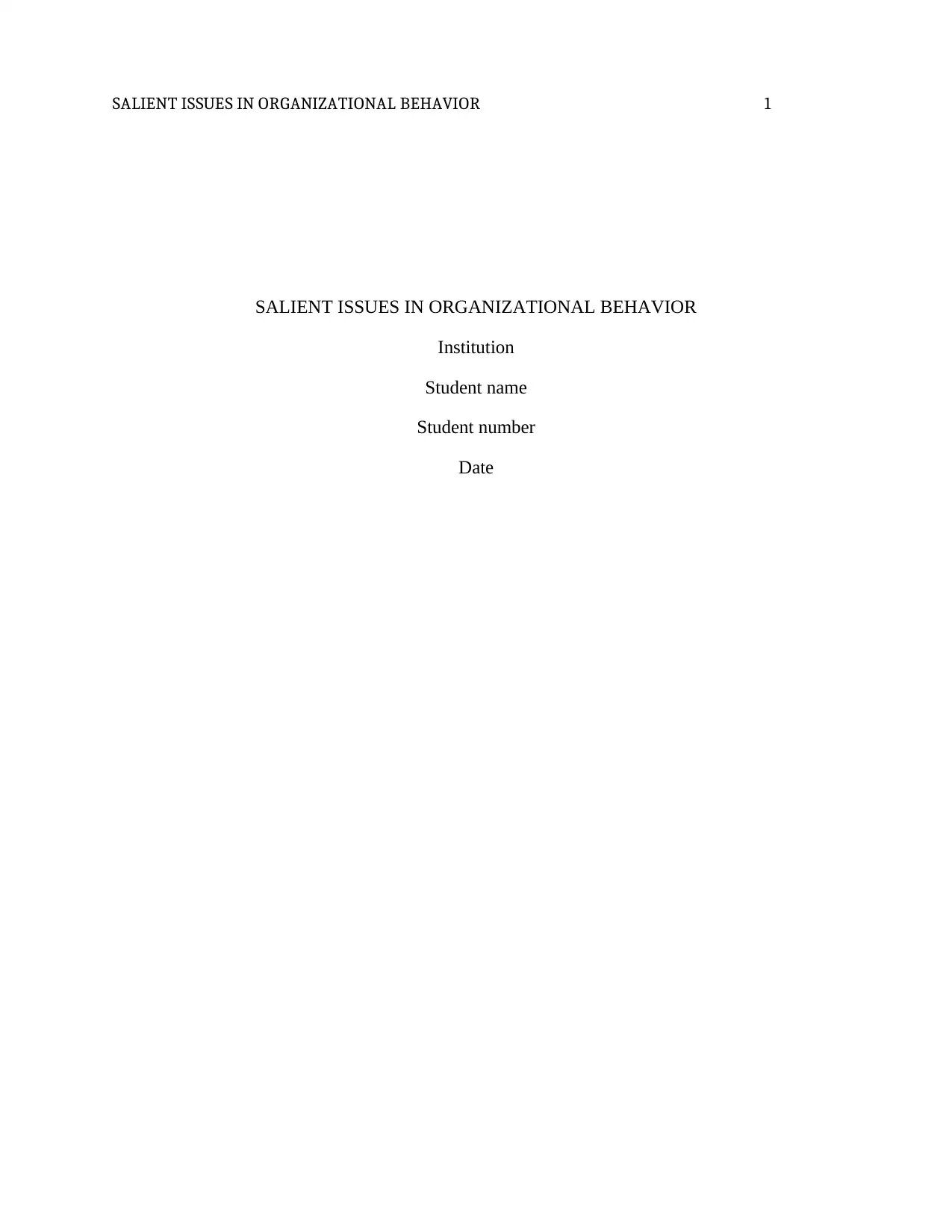
SALIENT ISSUES IN ORGANIZATIONAL BEHAVIOR 1
SALIENT ISSUES IN ORGANIZATIONAL BEHAVIOR
Institution
Student name
Student number
Date
SALIENT ISSUES IN ORGANIZATIONAL BEHAVIOR
Institution
Student name
Student number
Date
Paraphrase This Document
Need a fresh take? Get an instant paraphrase of this document with our AI Paraphraser
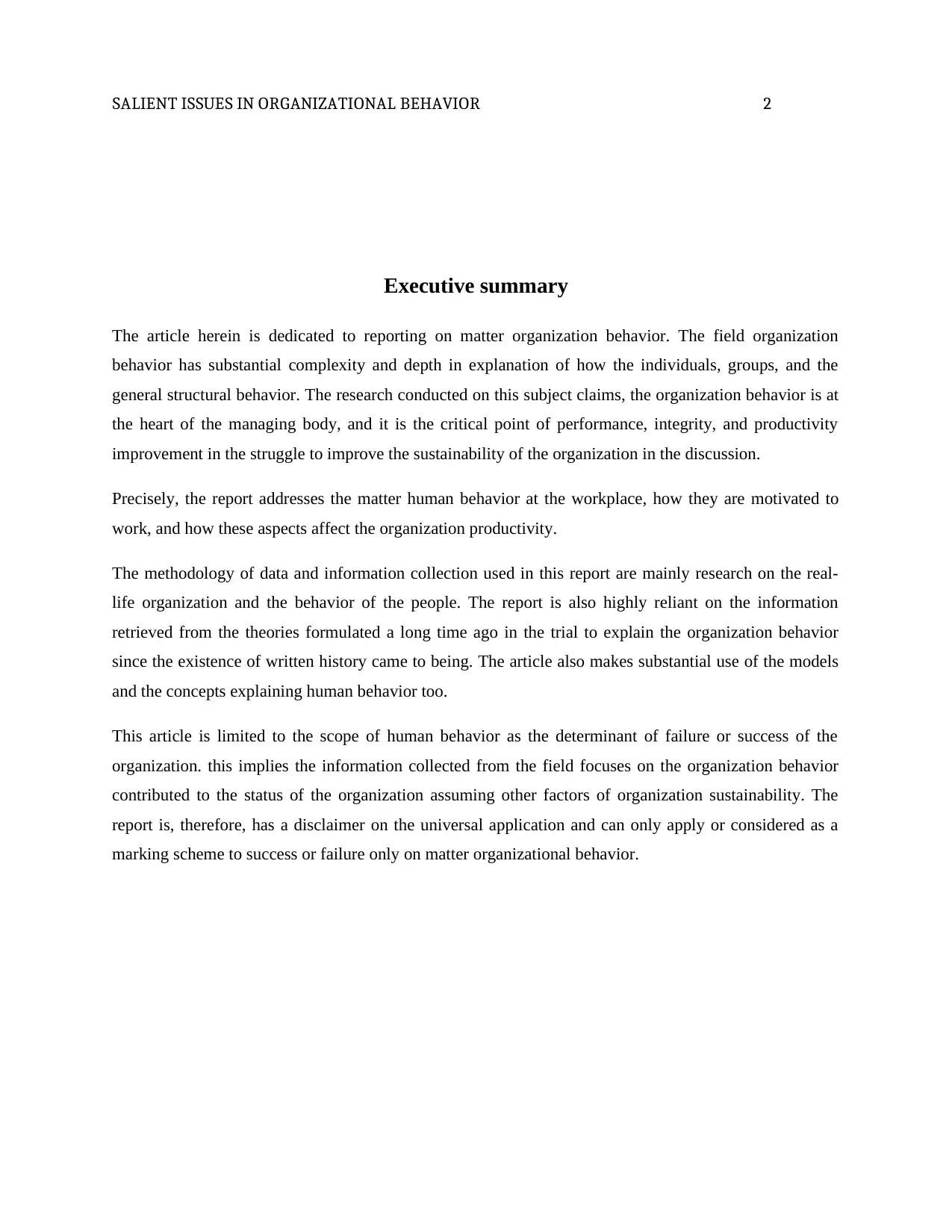
SALIENT ISSUES IN ORGANIZATIONAL BEHAVIOR 2
Executive summary
The article herein is dedicated to reporting on matter organization behavior. The field organization
behavior has substantial complexity and depth in explanation of how the individuals, groups, and the
general structural behavior. The research conducted on this subject claims, the organization behavior is at
the heart of the managing body, and it is the critical point of performance, integrity, and productivity
improvement in the struggle to improve the sustainability of the organization in the discussion.
Precisely, the report addresses the matter human behavior at the workplace, how they are motivated to
work, and how these aspects affect the organization productivity.
The methodology of data and information collection used in this report are mainly research on the real-
life organization and the behavior of the people. The report is also highly reliant on the information
retrieved from the theories formulated a long time ago in the trial to explain the organization behavior
since the existence of written history came to being. The article also makes substantial use of the models
and the concepts explaining human behavior too.
This article is limited to the scope of human behavior as the determinant of failure or success of the
organization. this implies the information collected from the field focuses on the organization behavior
contributed to the status of the organization assuming other factors of organization sustainability. The
report is, therefore, has a disclaimer on the universal application and can only apply or considered as a
marking scheme to success or failure only on matter organizational behavior.
Executive summary
The article herein is dedicated to reporting on matter organization behavior. The field organization
behavior has substantial complexity and depth in explanation of how the individuals, groups, and the
general structural behavior. The research conducted on this subject claims, the organization behavior is at
the heart of the managing body, and it is the critical point of performance, integrity, and productivity
improvement in the struggle to improve the sustainability of the organization in the discussion.
Precisely, the report addresses the matter human behavior at the workplace, how they are motivated to
work, and how these aspects affect the organization productivity.
The methodology of data and information collection used in this report are mainly research on the real-
life organization and the behavior of the people. The report is also highly reliant on the information
retrieved from the theories formulated a long time ago in the trial to explain the organization behavior
since the existence of written history came to being. The article also makes substantial use of the models
and the concepts explaining human behavior too.
This article is limited to the scope of human behavior as the determinant of failure or success of the
organization. this implies the information collected from the field focuses on the organization behavior
contributed to the status of the organization assuming other factors of organization sustainability. The
report is, therefore, has a disclaimer on the universal application and can only apply or considered as a
marking scheme to success or failure only on matter organizational behavior.
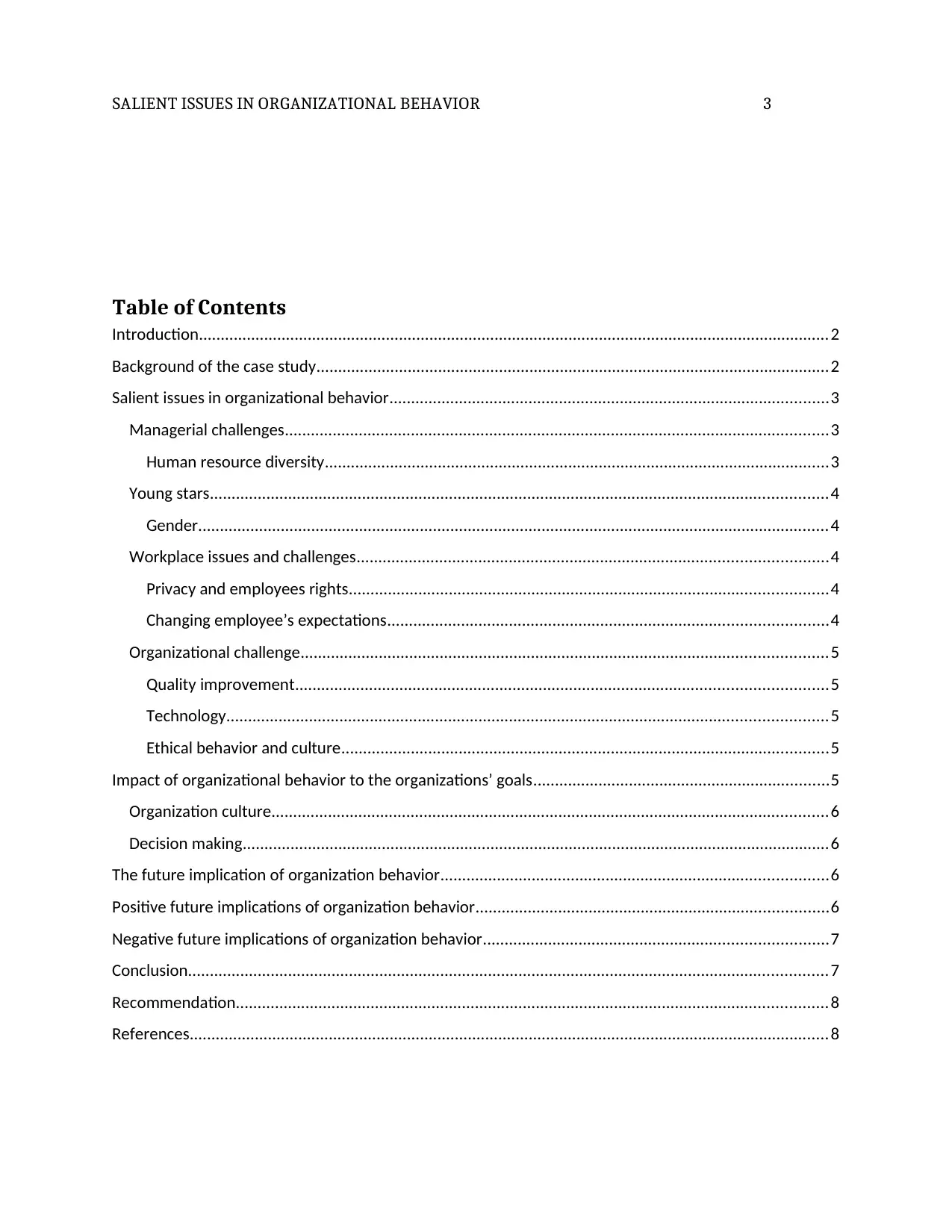
SALIENT ISSUES IN ORGANIZATIONAL BEHAVIOR 3
Table of Contents
Introduction.................................................................................................................................................2
Background of the case study......................................................................................................................2
Salient issues in organizational behavior.....................................................................................................3
Managerial challenges.............................................................................................................................3
Human resource diversity....................................................................................................................3
Young stars..............................................................................................................................................4
Gender.................................................................................................................................................4
Workplace issues and challenges............................................................................................................4
Privacy and employees rights..............................................................................................................4
Changing employee’s expectations.....................................................................................................4
Organizational challenge.........................................................................................................................5
Quality improvement..........................................................................................................................5
Technology..........................................................................................................................................5
Ethical behavior and culture................................................................................................................5
Impact of organizational behavior to the organizations’ goals....................................................................5
Organization culture................................................................................................................................6
Decision making.......................................................................................................................................6
The future implication of organization behavior.........................................................................................6
Positive future implications of organization behavior.................................................................................6
Negative future implications of organization behavior...............................................................................7
Conclusion...................................................................................................................................................7
Recommendation........................................................................................................................................8
References...................................................................................................................................................8
Table of Contents
Introduction.................................................................................................................................................2
Background of the case study......................................................................................................................2
Salient issues in organizational behavior.....................................................................................................3
Managerial challenges.............................................................................................................................3
Human resource diversity....................................................................................................................3
Young stars..............................................................................................................................................4
Gender.................................................................................................................................................4
Workplace issues and challenges............................................................................................................4
Privacy and employees rights..............................................................................................................4
Changing employee’s expectations.....................................................................................................4
Organizational challenge.........................................................................................................................5
Quality improvement..........................................................................................................................5
Technology..........................................................................................................................................5
Ethical behavior and culture................................................................................................................5
Impact of organizational behavior to the organizations’ goals....................................................................5
Organization culture................................................................................................................................6
Decision making.......................................................................................................................................6
The future implication of organization behavior.........................................................................................6
Positive future implications of organization behavior.................................................................................6
Negative future implications of organization behavior...............................................................................7
Conclusion...................................................................................................................................................7
Recommendation........................................................................................................................................8
References...................................................................................................................................................8
⊘ This is a preview!⊘
Do you want full access?
Subscribe today to unlock all pages.

Trusted by 1+ million students worldwide
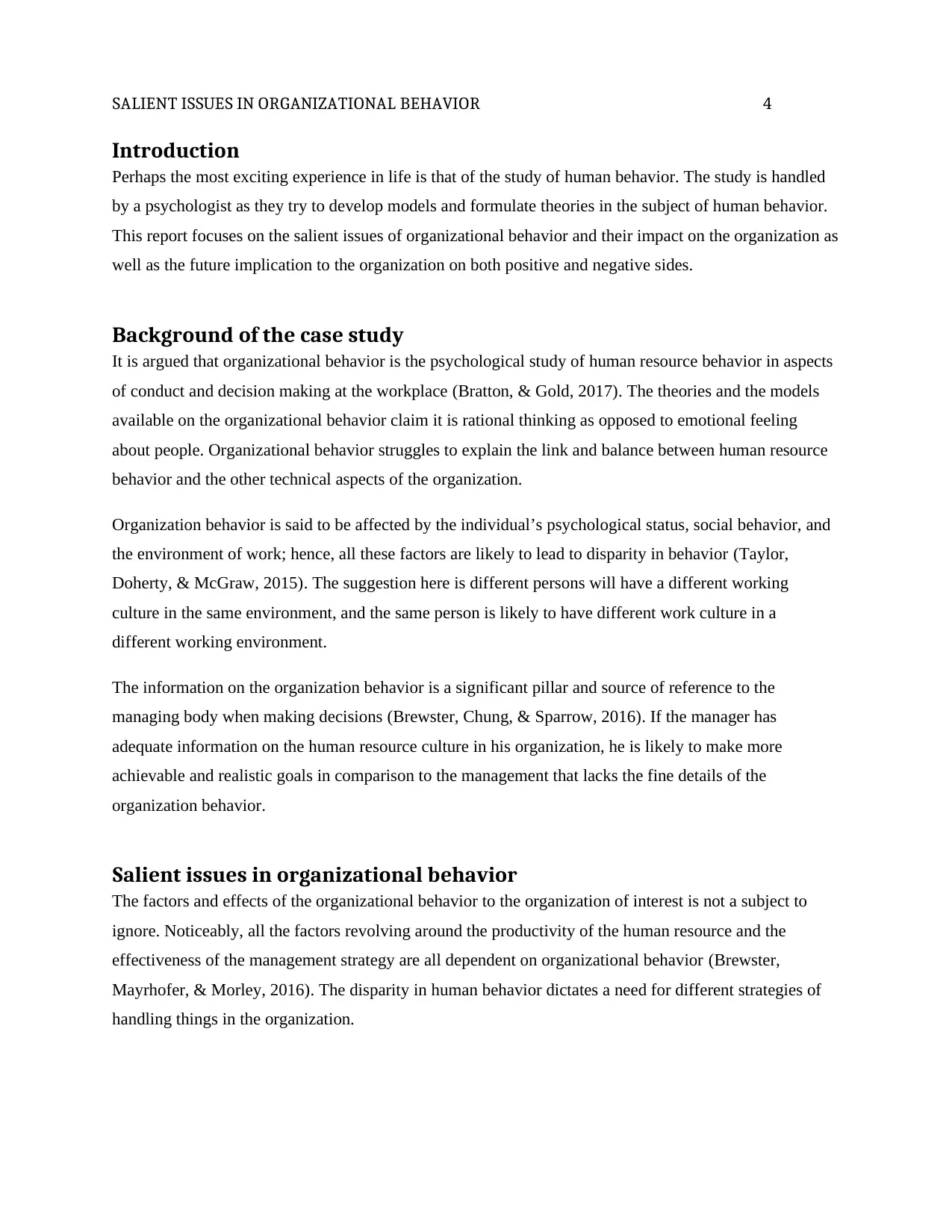
SALIENT ISSUES IN ORGANIZATIONAL BEHAVIOR 4
Introduction
Perhaps the most exciting experience in life is that of the study of human behavior. The study is handled
by a psychologist as they try to develop models and formulate theories in the subject of human behavior.
This report focuses on the salient issues of organizational behavior and their impact on the organization as
well as the future implication to the organization on both positive and negative sides.
Background of the case study
It is argued that organizational behavior is the psychological study of human resource behavior in aspects
of conduct and decision making at the workplace (Bratton, & Gold, 2017). The theories and the models
available on the organizational behavior claim it is rational thinking as opposed to emotional feeling
about people. Organizational behavior struggles to explain the link and balance between human resource
behavior and the other technical aspects of the organization.
Organization behavior is said to be affected by the individual’s psychological status, social behavior, and
the environment of work; hence, all these factors are likely to lead to disparity in behavior (Taylor,
Doherty, & McGraw, 2015). The suggestion here is different persons will have a different working
culture in the same environment, and the same person is likely to have different work culture in a
different working environment.
The information on the organization behavior is a significant pillar and source of reference to the
managing body when making decisions (Brewster, Chung, & Sparrow, 2016). If the manager has
adequate information on the human resource culture in his organization, he is likely to make more
achievable and realistic goals in comparison to the management that lacks the fine details of the
organization behavior.
Salient issues in organizational behavior
The factors and effects of the organizational behavior to the organization of interest is not a subject to
ignore. Noticeably, all the factors revolving around the productivity of the human resource and the
effectiveness of the management strategy are all dependent on organizational behavior (Brewster,
Mayrhofer, & Morley, 2016). The disparity in human behavior dictates a need for different strategies of
handling things in the organization.
Introduction
Perhaps the most exciting experience in life is that of the study of human behavior. The study is handled
by a psychologist as they try to develop models and formulate theories in the subject of human behavior.
This report focuses on the salient issues of organizational behavior and their impact on the organization as
well as the future implication to the organization on both positive and negative sides.
Background of the case study
It is argued that organizational behavior is the psychological study of human resource behavior in aspects
of conduct and decision making at the workplace (Bratton, & Gold, 2017). The theories and the models
available on the organizational behavior claim it is rational thinking as opposed to emotional feeling
about people. Organizational behavior struggles to explain the link and balance between human resource
behavior and the other technical aspects of the organization.
Organization behavior is said to be affected by the individual’s psychological status, social behavior, and
the environment of work; hence, all these factors are likely to lead to disparity in behavior (Taylor,
Doherty, & McGraw, 2015). The suggestion here is different persons will have a different working
culture in the same environment, and the same person is likely to have different work culture in a
different working environment.
The information on the organization behavior is a significant pillar and source of reference to the
managing body when making decisions (Brewster, Chung, & Sparrow, 2016). If the manager has
adequate information on the human resource culture in his organization, he is likely to make more
achievable and realistic goals in comparison to the management that lacks the fine details of the
organization behavior.
Salient issues in organizational behavior
The factors and effects of the organizational behavior to the organization of interest is not a subject to
ignore. Noticeably, all the factors revolving around the productivity of the human resource and the
effectiveness of the management strategy are all dependent on organizational behavior (Brewster,
Mayrhofer, & Morley, 2016). The disparity in human behavior dictates a need for different strategies of
handling things in the organization.
Paraphrase This Document
Need a fresh take? Get an instant paraphrase of this document with our AI Paraphraser
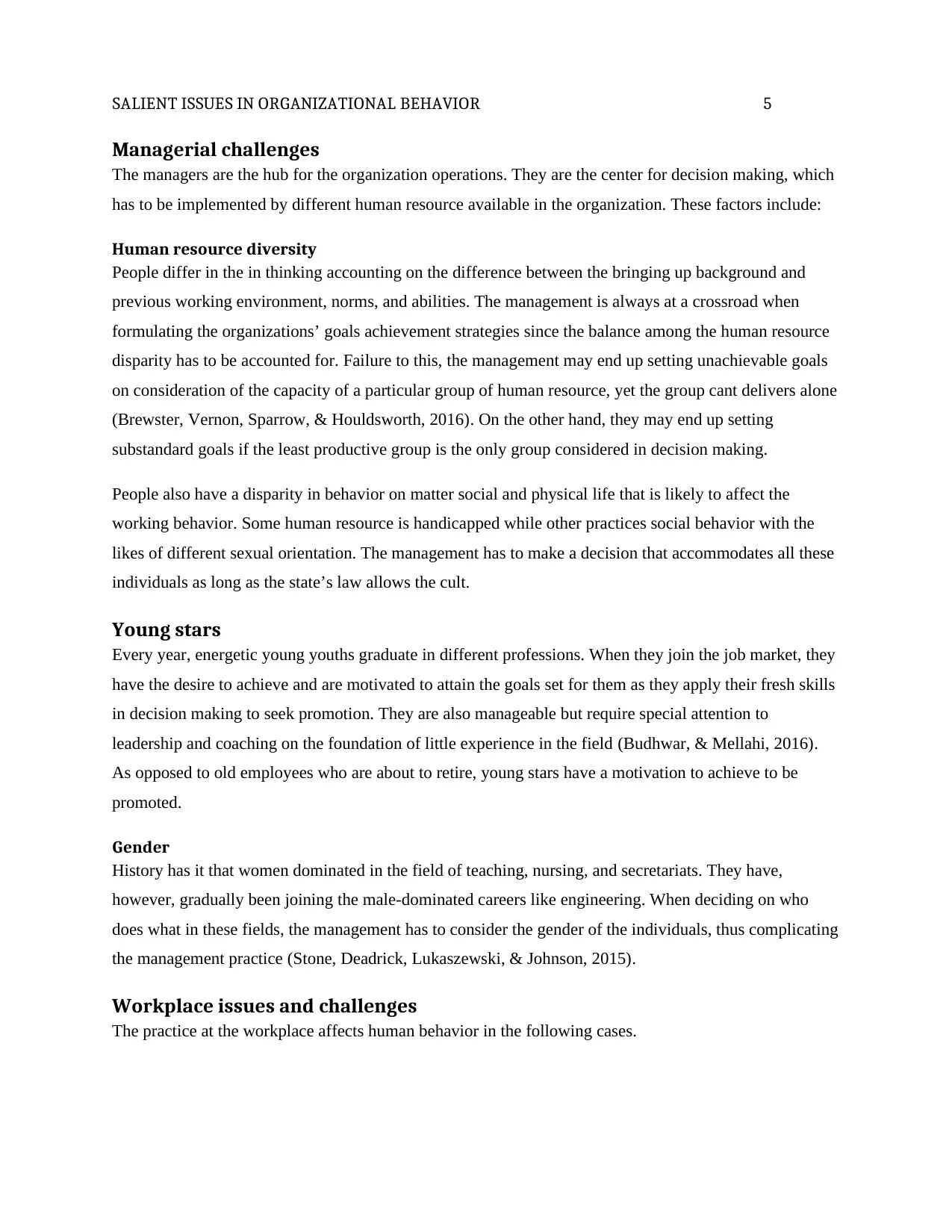
SALIENT ISSUES IN ORGANIZATIONAL BEHAVIOR 5
Managerial challenges
The managers are the hub for the organization operations. They are the center for decision making, which
has to be implemented by different human resource available in the organization. These factors include:
Human resource diversity
People differ in the in thinking accounting on the difference between the bringing up background and
previous working environment, norms, and abilities. The management is always at a crossroad when
formulating the organizations’ goals achievement strategies since the balance among the human resource
disparity has to be accounted for. Failure to this, the management may end up setting unachievable goals
on consideration of the capacity of a particular group of human resource, yet the group cant delivers alone
(Brewster, Vernon, Sparrow, & Houldsworth, 2016). On the other hand, they may end up setting
substandard goals if the least productive group is the only group considered in decision making.
People also have a disparity in behavior on matter social and physical life that is likely to affect the
working behavior. Some human resource is handicapped while other practices social behavior with the
likes of different sexual orientation. The management has to make a decision that accommodates all these
individuals as long as the state’s law allows the cult.
Young stars
Every year, energetic young youths graduate in different professions. When they join the job market, they
have the desire to achieve and are motivated to attain the goals set for them as they apply their fresh skills
in decision making to seek promotion. They are also manageable but require special attention to
leadership and coaching on the foundation of little experience in the field (Budhwar, & Mellahi, 2016).
As opposed to old employees who are about to retire, young stars have a motivation to achieve to be
promoted.
Gender
History has it that women dominated in the field of teaching, nursing, and secretariats. They have,
however, gradually been joining the male-dominated careers like engineering. When deciding on who
does what in these fields, the management has to consider the gender of the individuals, thus complicating
the management practice (Stone, Deadrick, Lukaszewski, & Johnson, 2015).
Workplace issues and challenges
The practice at the workplace affects human behavior in the following cases.
Managerial challenges
The managers are the hub for the organization operations. They are the center for decision making, which
has to be implemented by different human resource available in the organization. These factors include:
Human resource diversity
People differ in the in thinking accounting on the difference between the bringing up background and
previous working environment, norms, and abilities. The management is always at a crossroad when
formulating the organizations’ goals achievement strategies since the balance among the human resource
disparity has to be accounted for. Failure to this, the management may end up setting unachievable goals
on consideration of the capacity of a particular group of human resource, yet the group cant delivers alone
(Brewster, Vernon, Sparrow, & Houldsworth, 2016). On the other hand, they may end up setting
substandard goals if the least productive group is the only group considered in decision making.
People also have a disparity in behavior on matter social and physical life that is likely to affect the
working behavior. Some human resource is handicapped while other practices social behavior with the
likes of different sexual orientation. The management has to make a decision that accommodates all these
individuals as long as the state’s law allows the cult.
Young stars
Every year, energetic young youths graduate in different professions. When they join the job market, they
have the desire to achieve and are motivated to attain the goals set for them as they apply their fresh skills
in decision making to seek promotion. They are also manageable but require special attention to
leadership and coaching on the foundation of little experience in the field (Budhwar, & Mellahi, 2016).
As opposed to old employees who are about to retire, young stars have a motivation to achieve to be
promoted.
Gender
History has it that women dominated in the field of teaching, nursing, and secretariats. They have,
however, gradually been joining the male-dominated careers like engineering. When deciding on who
does what in these fields, the management has to consider the gender of the individuals, thus complicating
the management practice (Stone, Deadrick, Lukaszewski, & Johnson, 2015).
Workplace issues and challenges
The practice at the workplace affects human behavior in the following cases.
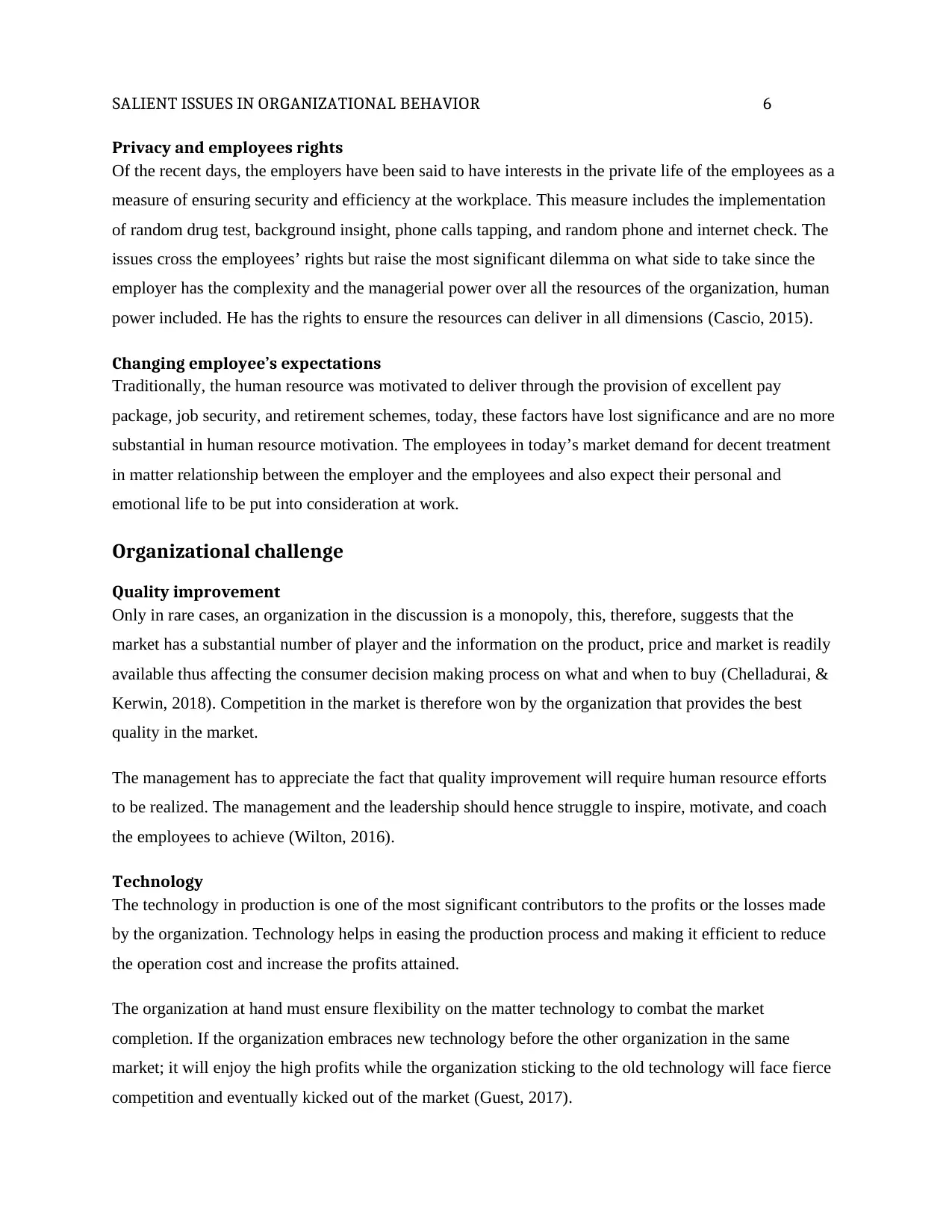
SALIENT ISSUES IN ORGANIZATIONAL BEHAVIOR 6
Privacy and employees rights
Of the recent days, the employers have been said to have interests in the private life of the employees as a
measure of ensuring security and efficiency at the workplace. This measure includes the implementation
of random drug test, background insight, phone calls tapping, and random phone and internet check. The
issues cross the employees’ rights but raise the most significant dilemma on what side to take since the
employer has the complexity and the managerial power over all the resources of the organization, human
power included. He has the rights to ensure the resources can deliver in all dimensions (Cascio, 2015).
Changing employee’s expectations
Traditionally, the human resource was motivated to deliver through the provision of excellent pay
package, job security, and retirement schemes, today, these factors have lost significance and are no more
substantial in human resource motivation. The employees in today’s market demand for decent treatment
in matter relationship between the employer and the employees and also expect their personal and
emotional life to be put into consideration at work.
Organizational challenge
Quality improvement
Only in rare cases, an organization in the discussion is a monopoly, this, therefore, suggests that the
market has a substantial number of player and the information on the product, price and market is readily
available thus affecting the consumer decision making process on what and when to buy (Chelladurai, &
Kerwin, 2018). Competition in the market is therefore won by the organization that provides the best
quality in the market.
The management has to appreciate the fact that quality improvement will require human resource efforts
to be realized. The management and the leadership should hence struggle to inspire, motivate, and coach
the employees to achieve (Wilton, 2016).
Technology
The technology in production is one of the most significant contributors to the profits or the losses made
by the organization. Technology helps in easing the production process and making it efficient to reduce
the operation cost and increase the profits attained.
The organization at hand must ensure flexibility on the matter technology to combat the market
completion. If the organization embraces new technology before the other organization in the same
market; it will enjoy the high profits while the organization sticking to the old technology will face fierce
competition and eventually kicked out of the market (Guest, 2017).
Privacy and employees rights
Of the recent days, the employers have been said to have interests in the private life of the employees as a
measure of ensuring security and efficiency at the workplace. This measure includes the implementation
of random drug test, background insight, phone calls tapping, and random phone and internet check. The
issues cross the employees’ rights but raise the most significant dilemma on what side to take since the
employer has the complexity and the managerial power over all the resources of the organization, human
power included. He has the rights to ensure the resources can deliver in all dimensions (Cascio, 2015).
Changing employee’s expectations
Traditionally, the human resource was motivated to deliver through the provision of excellent pay
package, job security, and retirement schemes, today, these factors have lost significance and are no more
substantial in human resource motivation. The employees in today’s market demand for decent treatment
in matter relationship between the employer and the employees and also expect their personal and
emotional life to be put into consideration at work.
Organizational challenge
Quality improvement
Only in rare cases, an organization in the discussion is a monopoly, this, therefore, suggests that the
market has a substantial number of player and the information on the product, price and market is readily
available thus affecting the consumer decision making process on what and when to buy (Chelladurai, &
Kerwin, 2018). Competition in the market is therefore won by the organization that provides the best
quality in the market.
The management has to appreciate the fact that quality improvement will require human resource efforts
to be realized. The management and the leadership should hence struggle to inspire, motivate, and coach
the employees to achieve (Wilton, 2016).
Technology
The technology in production is one of the most significant contributors to the profits or the losses made
by the organization. Technology helps in easing the production process and making it efficient to reduce
the operation cost and increase the profits attained.
The organization at hand must ensure flexibility on the matter technology to combat the market
completion. If the organization embraces new technology before the other organization in the same
market; it will enjoy the high profits while the organization sticking to the old technology will face fierce
competition and eventually kicked out of the market (Guest, 2017).
⊘ This is a preview!⊘
Do you want full access?
Subscribe today to unlock all pages.

Trusted by 1+ million students worldwide
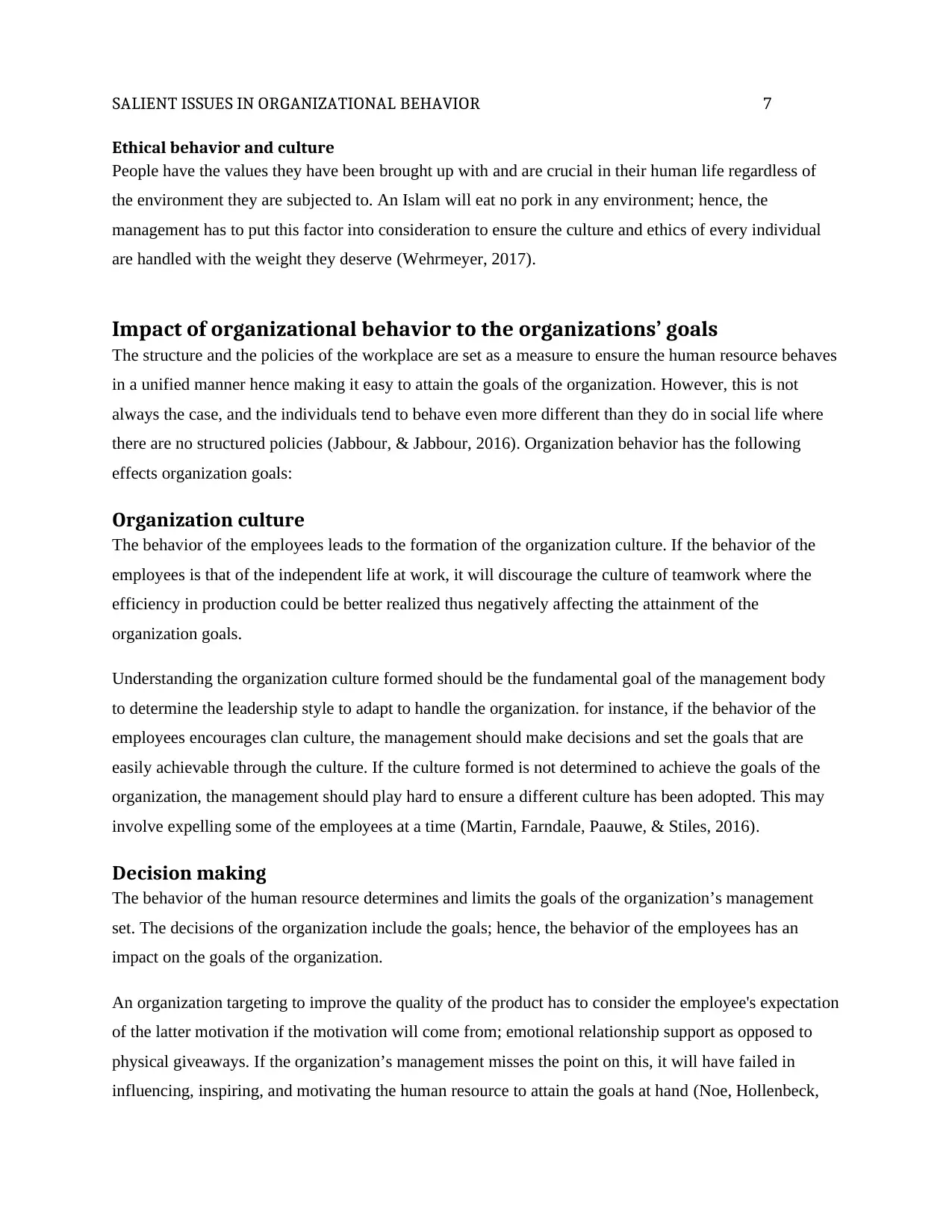
SALIENT ISSUES IN ORGANIZATIONAL BEHAVIOR 7
Ethical behavior and culture
People have the values they have been brought up with and are crucial in their human life regardless of
the environment they are subjected to. An Islam will eat no pork in any environment; hence, the
management has to put this factor into consideration to ensure the culture and ethics of every individual
are handled with the weight they deserve (Wehrmeyer, 2017).
Impact of organizational behavior to the organizations’ goals
The structure and the policies of the workplace are set as a measure to ensure the human resource behaves
in a unified manner hence making it easy to attain the goals of the organization. However, this is not
always the case, and the individuals tend to behave even more different than they do in social life where
there are no structured policies (Jabbour, & Jabbour, 2016). Organization behavior has the following
effects organization goals:
Organization culture
The behavior of the employees leads to the formation of the organization culture. If the behavior of the
employees is that of the independent life at work, it will discourage the culture of teamwork where the
efficiency in production could be better realized thus negatively affecting the attainment of the
organization goals.
Understanding the organization culture formed should be the fundamental goal of the management body
to determine the leadership style to adapt to handle the organization. for instance, if the behavior of the
employees encourages clan culture, the management should make decisions and set the goals that are
easily achievable through the culture. If the culture formed is not determined to achieve the goals of the
organization, the management should play hard to ensure a different culture has been adopted. This may
involve expelling some of the employees at a time (Martin, Farndale, Paauwe, & Stiles, 2016).
Decision making
The behavior of the human resource determines and limits the goals of the organization’s management
set. The decisions of the organization include the goals; hence, the behavior of the employees has an
impact on the goals of the organization.
An organization targeting to improve the quality of the product has to consider the employee's expectation
of the latter motivation if the motivation will come from; emotional relationship support as opposed to
physical giveaways. If the organization’s management misses the point on this, it will have failed in
influencing, inspiring, and motivating the human resource to attain the goals at hand (Noe, Hollenbeck,
Ethical behavior and culture
People have the values they have been brought up with and are crucial in their human life regardless of
the environment they are subjected to. An Islam will eat no pork in any environment; hence, the
management has to put this factor into consideration to ensure the culture and ethics of every individual
are handled with the weight they deserve (Wehrmeyer, 2017).
Impact of organizational behavior to the organizations’ goals
The structure and the policies of the workplace are set as a measure to ensure the human resource behaves
in a unified manner hence making it easy to attain the goals of the organization. However, this is not
always the case, and the individuals tend to behave even more different than they do in social life where
there are no structured policies (Jabbour, & Jabbour, 2016). Organization behavior has the following
effects organization goals:
Organization culture
The behavior of the employees leads to the formation of the organization culture. If the behavior of the
employees is that of the independent life at work, it will discourage the culture of teamwork where the
efficiency in production could be better realized thus negatively affecting the attainment of the
organization goals.
Understanding the organization culture formed should be the fundamental goal of the management body
to determine the leadership style to adapt to handle the organization. for instance, if the behavior of the
employees encourages clan culture, the management should make decisions and set the goals that are
easily achievable through the culture. If the culture formed is not determined to achieve the goals of the
organization, the management should play hard to ensure a different culture has been adopted. This may
involve expelling some of the employees at a time (Martin, Farndale, Paauwe, & Stiles, 2016).
Decision making
The behavior of the human resource determines and limits the goals of the organization’s management
set. The decisions of the organization include the goals; hence, the behavior of the employees has an
impact on the goals of the organization.
An organization targeting to improve the quality of the product has to consider the employee's expectation
of the latter motivation if the motivation will come from; emotional relationship support as opposed to
physical giveaways. If the organization’s management misses the point on this, it will have failed in
influencing, inspiring, and motivating the human resource to attain the goals at hand (Noe, Hollenbeck,
Paraphrase This Document
Need a fresh take? Get an instant paraphrase of this document with our AI Paraphraser
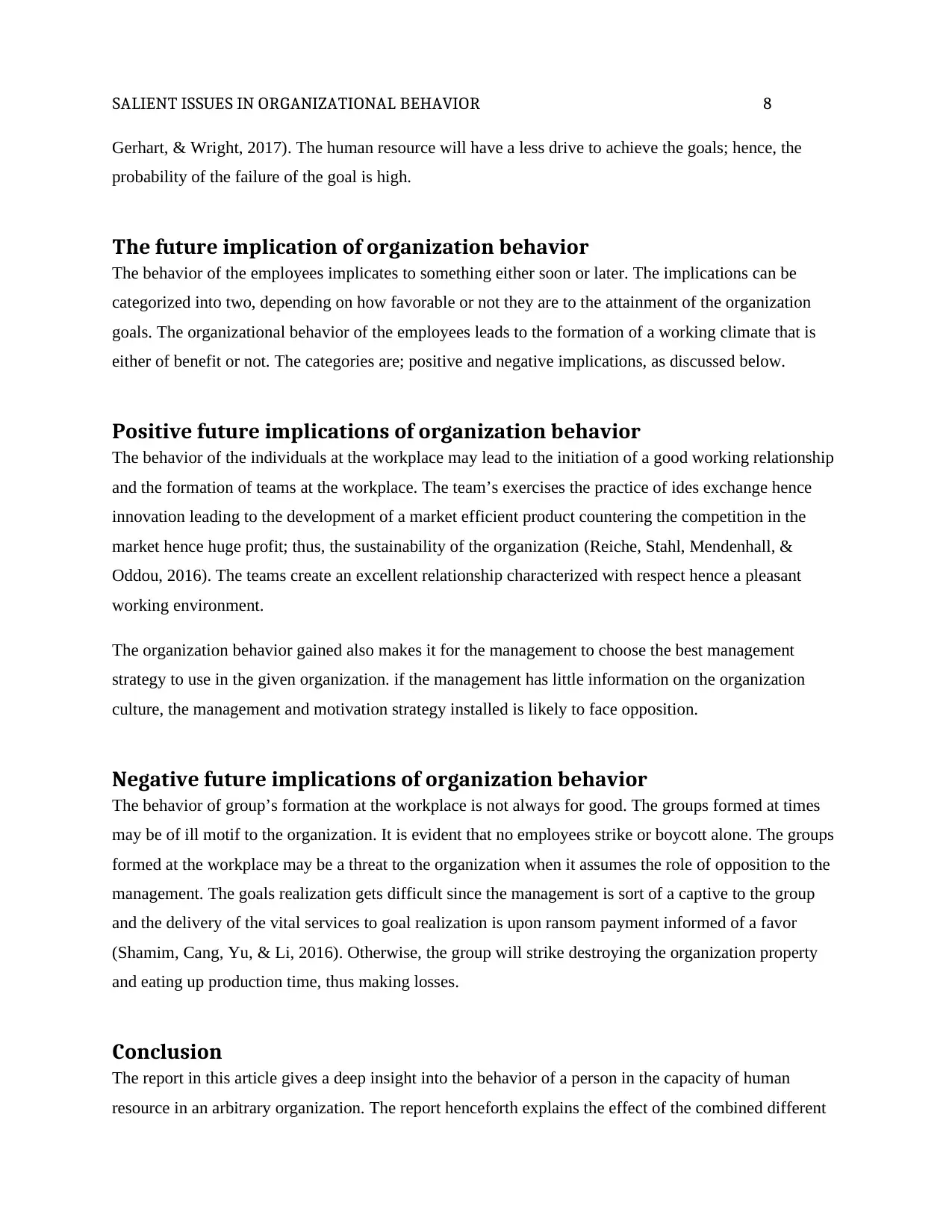
SALIENT ISSUES IN ORGANIZATIONAL BEHAVIOR 8
Gerhart, & Wright, 2017). The human resource will have a less drive to achieve the goals; hence, the
probability of the failure of the goal is high.
The future implication of organization behavior
The behavior of the employees implicates to something either soon or later. The implications can be
categorized into two, depending on how favorable or not they are to the attainment of the organization
goals. The organizational behavior of the employees leads to the formation of a working climate that is
either of benefit or not. The categories are; positive and negative implications, as discussed below.
Positive future implications of organization behavior
The behavior of the individuals at the workplace may lead to the initiation of a good working relationship
and the formation of teams at the workplace. The team’s exercises the practice of ides exchange hence
innovation leading to the development of a market efficient product countering the competition in the
market hence huge profit; thus, the sustainability of the organization (Reiche, Stahl, Mendenhall, &
Oddou, 2016). The teams create an excellent relationship characterized with respect hence a pleasant
working environment.
The organization behavior gained also makes it for the management to choose the best management
strategy to use in the given organization. if the management has little information on the organization
culture, the management and motivation strategy installed is likely to face opposition.
Negative future implications of organization behavior
The behavior of group’s formation at the workplace is not always for good. The groups formed at times
may be of ill motif to the organization. It is evident that no employees strike or boycott alone. The groups
formed at the workplace may be a threat to the organization when it assumes the role of opposition to the
management. The goals realization gets difficult since the management is sort of a captive to the group
and the delivery of the vital services to goal realization is upon ransom payment informed of a favor
(Shamim, Cang, Yu, & Li, 2016). Otherwise, the group will strike destroying the organization property
and eating up production time, thus making losses.
Conclusion
The report in this article gives a deep insight into the behavior of a person in the capacity of human
resource in an arbitrary organization. The report henceforth explains the effect of the combined different
Gerhart, & Wright, 2017). The human resource will have a less drive to achieve the goals; hence, the
probability of the failure of the goal is high.
The future implication of organization behavior
The behavior of the employees implicates to something either soon or later. The implications can be
categorized into two, depending on how favorable or not they are to the attainment of the organization
goals. The organizational behavior of the employees leads to the formation of a working climate that is
either of benefit or not. The categories are; positive and negative implications, as discussed below.
Positive future implications of organization behavior
The behavior of the individuals at the workplace may lead to the initiation of a good working relationship
and the formation of teams at the workplace. The team’s exercises the practice of ides exchange hence
innovation leading to the development of a market efficient product countering the competition in the
market hence huge profit; thus, the sustainability of the organization (Reiche, Stahl, Mendenhall, &
Oddou, 2016). The teams create an excellent relationship characterized with respect hence a pleasant
working environment.
The organization behavior gained also makes it for the management to choose the best management
strategy to use in the given organization. if the management has little information on the organization
culture, the management and motivation strategy installed is likely to face opposition.
Negative future implications of organization behavior
The behavior of group’s formation at the workplace is not always for good. The groups formed at times
may be of ill motif to the organization. It is evident that no employees strike or boycott alone. The groups
formed at the workplace may be a threat to the organization when it assumes the role of opposition to the
management. The goals realization gets difficult since the management is sort of a captive to the group
and the delivery of the vital services to goal realization is upon ransom payment informed of a favor
(Shamim, Cang, Yu, & Li, 2016). Otherwise, the group will strike destroying the organization property
and eating up production time, thus making losses.
Conclusion
The report in this article gives a deep insight into the behavior of a person in the capacity of human
resource in an arbitrary organization. The report henceforth explains the effect of the combined different
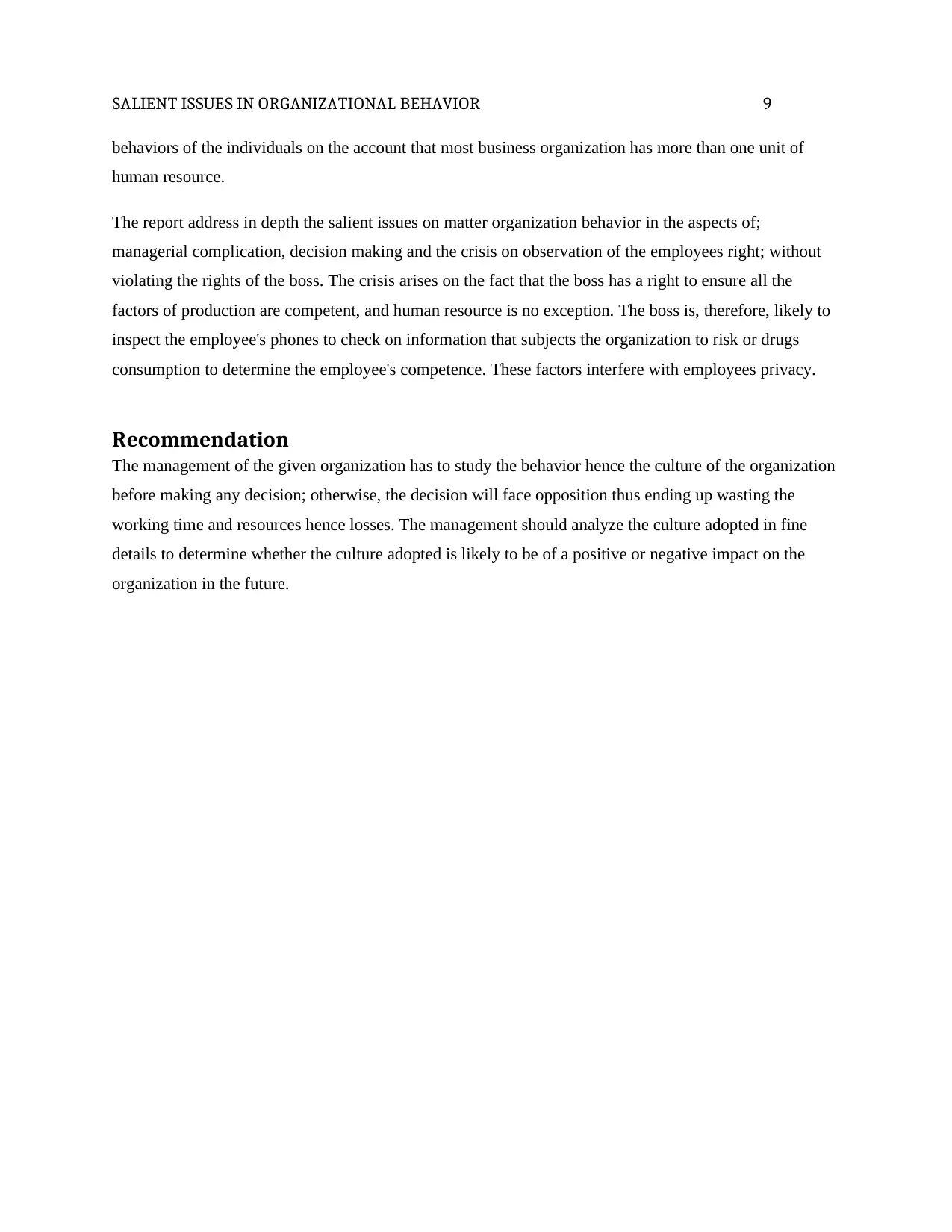
SALIENT ISSUES IN ORGANIZATIONAL BEHAVIOR 9
behaviors of the individuals on the account that most business organization has more than one unit of
human resource.
The report address in depth the salient issues on matter organization behavior in the aspects of;
managerial complication, decision making and the crisis on observation of the employees right; without
violating the rights of the boss. The crisis arises on the fact that the boss has a right to ensure all the
factors of production are competent, and human resource is no exception. The boss is, therefore, likely to
inspect the employee's phones to check on information that subjects the organization to risk or drugs
consumption to determine the employee's competence. These factors interfere with employees privacy.
Recommendation
The management of the given organization has to study the behavior hence the culture of the organization
before making any decision; otherwise, the decision will face opposition thus ending up wasting the
working time and resources hence losses. The management should analyze the culture adopted in fine
details to determine whether the culture adopted is likely to be of a positive or negative impact on the
organization in the future.
behaviors of the individuals on the account that most business organization has more than one unit of
human resource.
The report address in depth the salient issues on matter organization behavior in the aspects of;
managerial complication, decision making and the crisis on observation of the employees right; without
violating the rights of the boss. The crisis arises on the fact that the boss has a right to ensure all the
factors of production are competent, and human resource is no exception. The boss is, therefore, likely to
inspect the employee's phones to check on information that subjects the organization to risk or drugs
consumption to determine the employee's competence. These factors interfere with employees privacy.
Recommendation
The management of the given organization has to study the behavior hence the culture of the organization
before making any decision; otherwise, the decision will face opposition thus ending up wasting the
working time and resources hence losses. The management should analyze the culture adopted in fine
details to determine whether the culture adopted is likely to be of a positive or negative impact on the
organization in the future.
⊘ This is a preview!⊘
Do you want full access?
Subscribe today to unlock all pages.

Trusted by 1+ million students worldwide
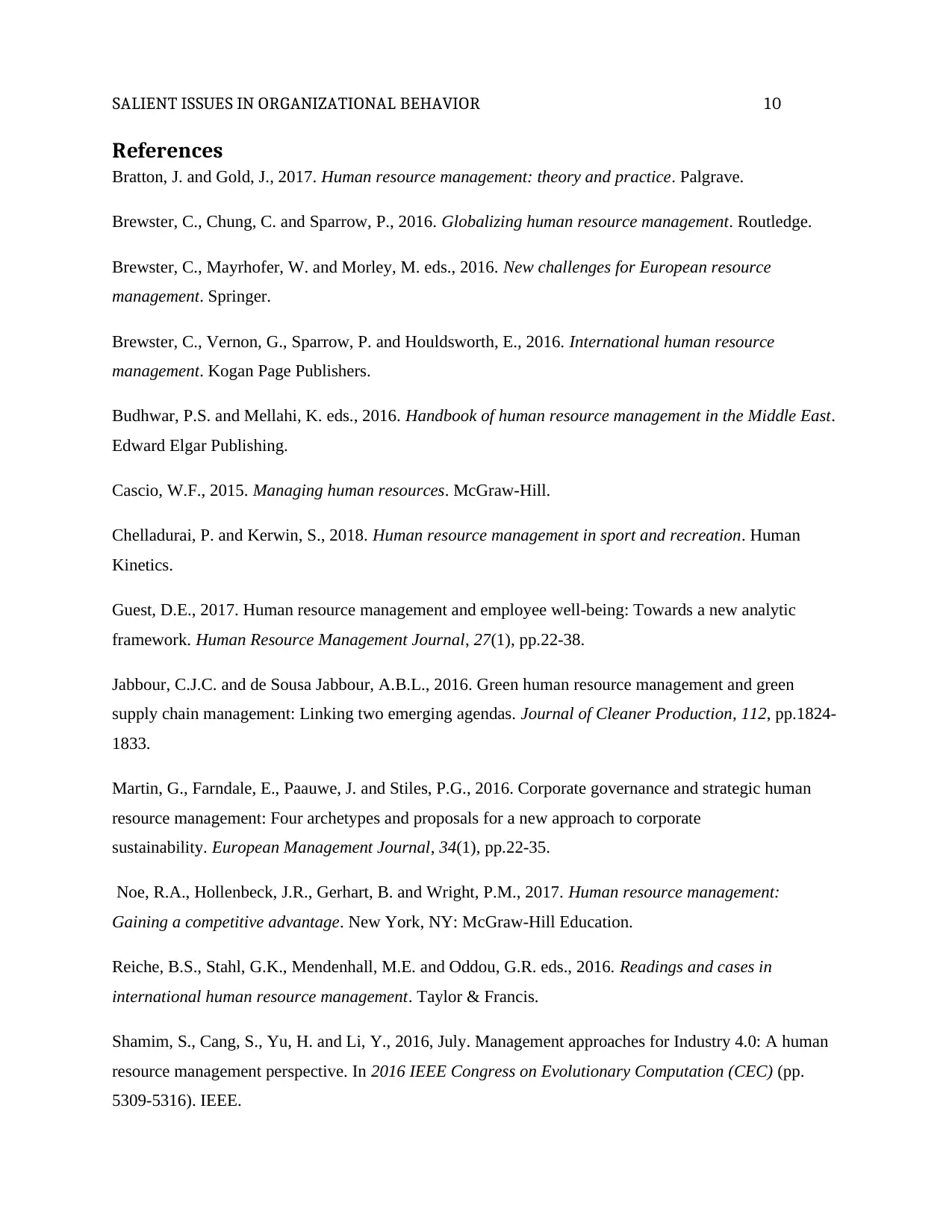
SALIENT ISSUES IN ORGANIZATIONAL BEHAVIOR 10
References
Bratton, J. and Gold, J., 2017. Human resource management: theory and practice. Palgrave.
Brewster, C., Chung, C. and Sparrow, P., 2016. Globalizing human resource management. Routledge.
Brewster, C., Mayrhofer, W. and Morley, M. eds., 2016. New challenges for European resource
management. Springer.
Brewster, C., Vernon, G., Sparrow, P. and Houldsworth, E., 2016. International human resource
management. Kogan Page Publishers.
Budhwar, P.S. and Mellahi, K. eds., 2016. Handbook of human resource management in the Middle East.
Edward Elgar Publishing.
Cascio, W.F., 2015. Managing human resources. McGraw-Hill.
Chelladurai, P. and Kerwin, S., 2018. Human resource management in sport and recreation. Human
Kinetics.
Guest, D.E., 2017. Human resource management and employee well‐being: Towards a new analytic
framework. Human Resource Management Journal, 27(1), pp.22-38.
Jabbour, C.J.C. and de Sousa Jabbour, A.B.L., 2016. Green human resource management and green
supply chain management: Linking two emerging agendas. Journal of Cleaner Production, 112, pp.1824-
1833.
Martin, G., Farndale, E., Paauwe, J. and Stiles, P.G., 2016. Corporate governance and strategic human
resource management: Four archetypes and proposals for a new approach to corporate
sustainability. European Management Journal, 34(1), pp.22-35.
Noe, R.A., Hollenbeck, J.R., Gerhart, B. and Wright, P.M., 2017. Human resource management:
Gaining a competitive advantage. New York, NY: McGraw-Hill Education.
Reiche, B.S., Stahl, G.K., Mendenhall, M.E. and Oddou, G.R. eds., 2016. Readings and cases in
international human resource management. Taylor & Francis.
Shamim, S., Cang, S., Yu, H. and Li, Y., 2016, July. Management approaches for Industry 4.0: A human
resource management perspective. In 2016 IEEE Congress on Evolutionary Computation (CEC) (pp.
5309-5316). IEEE.
References
Bratton, J. and Gold, J., 2017. Human resource management: theory and practice. Palgrave.
Brewster, C., Chung, C. and Sparrow, P., 2016. Globalizing human resource management. Routledge.
Brewster, C., Mayrhofer, W. and Morley, M. eds., 2016. New challenges for European resource
management. Springer.
Brewster, C., Vernon, G., Sparrow, P. and Houldsworth, E., 2016. International human resource
management. Kogan Page Publishers.
Budhwar, P.S. and Mellahi, K. eds., 2016. Handbook of human resource management in the Middle East.
Edward Elgar Publishing.
Cascio, W.F., 2015. Managing human resources. McGraw-Hill.
Chelladurai, P. and Kerwin, S., 2018. Human resource management in sport and recreation. Human
Kinetics.
Guest, D.E., 2017. Human resource management and employee well‐being: Towards a new analytic
framework. Human Resource Management Journal, 27(1), pp.22-38.
Jabbour, C.J.C. and de Sousa Jabbour, A.B.L., 2016. Green human resource management and green
supply chain management: Linking two emerging agendas. Journal of Cleaner Production, 112, pp.1824-
1833.
Martin, G., Farndale, E., Paauwe, J. and Stiles, P.G., 2016. Corporate governance and strategic human
resource management: Four archetypes and proposals for a new approach to corporate
sustainability. European Management Journal, 34(1), pp.22-35.
Noe, R.A., Hollenbeck, J.R., Gerhart, B. and Wright, P.M., 2017. Human resource management:
Gaining a competitive advantage. New York, NY: McGraw-Hill Education.
Reiche, B.S., Stahl, G.K., Mendenhall, M.E. and Oddou, G.R. eds., 2016. Readings and cases in
international human resource management. Taylor & Francis.
Shamim, S., Cang, S., Yu, H. and Li, Y., 2016, July. Management approaches for Industry 4.0: A human
resource management perspective. In 2016 IEEE Congress on Evolutionary Computation (CEC) (pp.
5309-5316). IEEE.
Paraphrase This Document
Need a fresh take? Get an instant paraphrase of this document with our AI Paraphraser
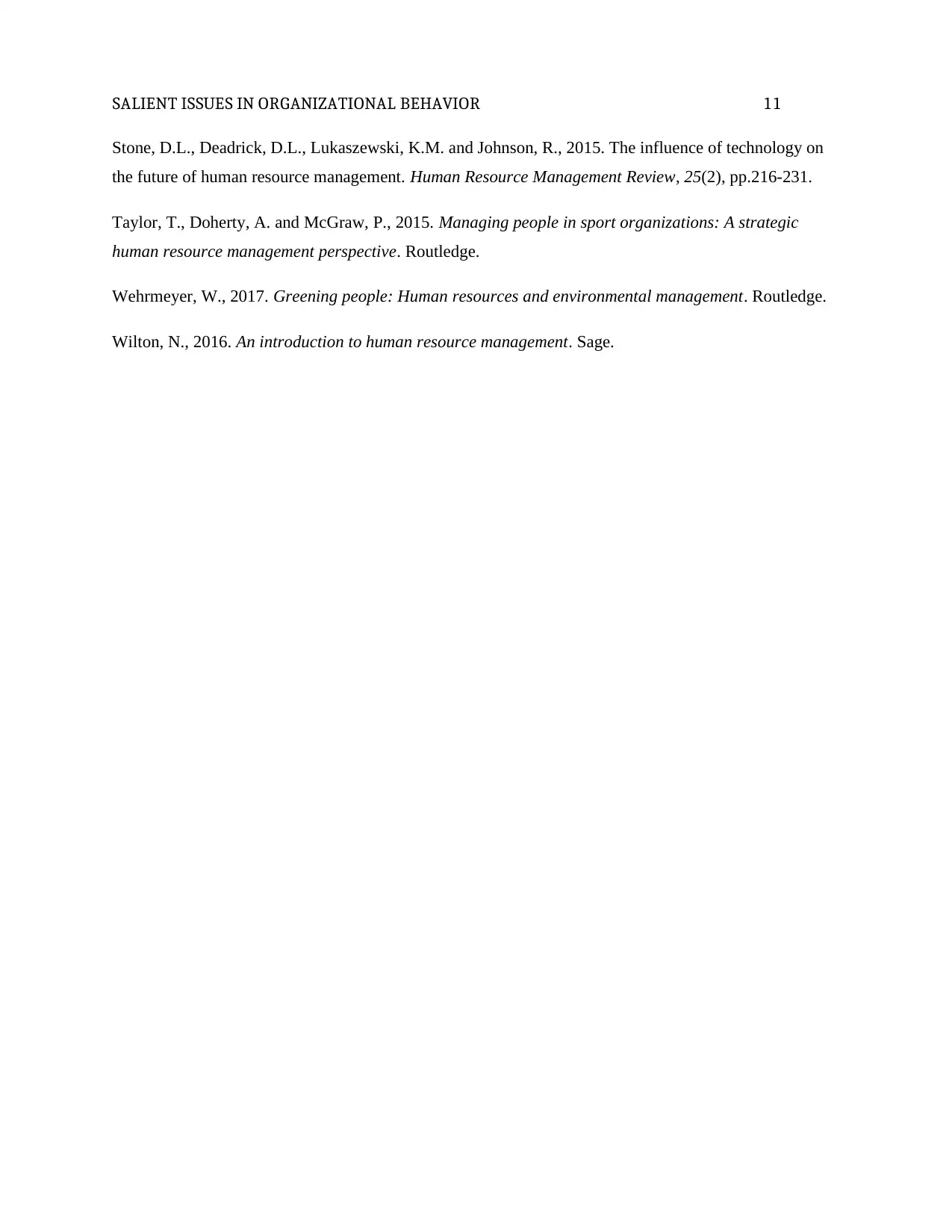
SALIENT ISSUES IN ORGANIZATIONAL BEHAVIOR 11
Stone, D.L., Deadrick, D.L., Lukaszewski, K.M. and Johnson, R., 2015. The influence of technology on
the future of human resource management. Human Resource Management Review, 25(2), pp.216-231.
Taylor, T., Doherty, A. and McGraw, P., 2015. Managing people in sport organizations: A strategic
human resource management perspective. Routledge.
Wehrmeyer, W., 2017. Greening people: Human resources and environmental management. Routledge.
Wilton, N., 2016. An introduction to human resource management. Sage.
Stone, D.L., Deadrick, D.L., Lukaszewski, K.M. and Johnson, R., 2015. The influence of technology on
the future of human resource management. Human Resource Management Review, 25(2), pp.216-231.
Taylor, T., Doherty, A. and McGraw, P., 2015. Managing people in sport organizations: A strategic
human resource management perspective. Routledge.
Wehrmeyer, W., 2017. Greening people: Human resources and environmental management. Routledge.
Wilton, N., 2016. An introduction to human resource management. Sage.
1 out of 11
Related Documents
Your All-in-One AI-Powered Toolkit for Academic Success.
+13062052269
info@desklib.com
Available 24*7 on WhatsApp / Email
![[object Object]](/_next/static/media/star-bottom.7253800d.svg)
Unlock your academic potential
Copyright © 2020–2025 A2Z Services. All Rights Reserved. Developed and managed by ZUCOL.





